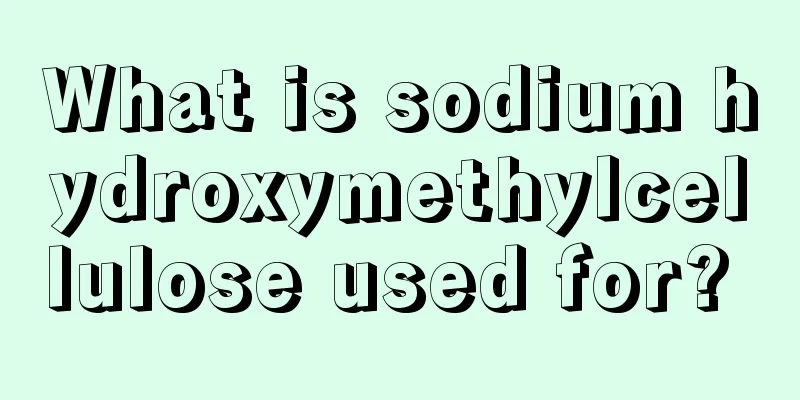What is sodium hydroxymethylcellulose used for?

|
Sodium hydroxymethyl cellulose is a white granular substance that is easily soluble in water and becomes sticky. Normally, the properties of sodium hydroxymethyl cellulose are very stable, but if it is dissolved in a liquid with a relatively high acidity, sodium hydroxymethyl cellulose will precipitate. Because of these characteristics, sodium hydroxymethyl cellulose has the following uses. What are the effects and uses of sodium carboxymethyl cellulose? Sodium carboxymethyl cellulose is the sodium salt of cellulose carboxymethyl ether, which is an anionic cellulose ether. It is a white or milky white fibrous powder or granules with a density of 0.5-0.7/cm2. It is almost odorless and tasteless and has hygroscopicity. It is easily dispersed in water to form a clear colloidal liquid, and is insoluble in organic solvents such as ethanol. Its effects and uses are summarized in detail below. Sodium carboxymethyl cellulose has the functions of bonding, thickening, strengthening, emulsifying, water retention and suspension. 1. Application of sodium carboxymethyl cellulose in the food industry: Sodium carboxymethyl cellulose is not only a good emulsifier stabilizer and thickener in food applications, but also has excellent freezing and melting stability, and can improve the flavor of the product and prolong the storage time. 2. Uses of sodium carboxymethyl cellulose in the pharmaceutical industry: In the pharmaceutical industry, it can be used as an emulsifier stabilizer for injections, a binder and film-forming agent for tablets. 3. CMC can be used as an anti-settling agent, emulsifier, dispersant, leveling agent, and adhesive for coatings. It can evenly distribute the solid content of the coating in the solvent, so that the coating will not be stratified for a long time. It is also widely used in paints. 4. Sodium carboxymethyl cellulose can be used as flocculant, chelating agent, emulsifier, thickener, water retaining agent, sizing agent, film-forming material, etc. It is also widely used in electronics, pesticides, leather, plastics, printing, ceramics, daily chemicals and other fields. Moreover, due to its excellent performance and wide range of uses, it is constantly exploring new application areas and has a very broad market prospect. nature: The aqueous solution is viscous. Viscosity and solubility are related to the degree of substitution. The solution is stable in the pH range of 2 to 10. Solids precipitate below pH 2, and the viscosity decreases rapidly above pH 10. Sodium carboxymethylcellulose (NaCMC or CMC for short) is a water-soluble cellulose ether that can make the viscosity of most commonly used aqueous solution preparations vary from a few cP to several thousand cP. The simplified molecular formula of NaCMC is as follows: Cell-O-CH2-COONaNaCMC is obtained by the reaction of monochloroacetic acid and alkaline cellulose. Alkali cellulose itself is produced by reacting cellulose with sodium hydroxide. The alkali cellulose step is necessary to facilitate the reaction between the etherifying agent and the cellulose chains. The degree of substitution (DS) and degree of polymerization (DP) are typical indicators of various grades of NaCMC. |
<<: What are the tips for using nitrocellulose?
>>: What is the function of cab cellulose?
Recommend
What's the matter with the black mole on the right shoulder?
Generally speaking, the black mole on the right s...
The advantages and disadvantages of crying on the body
Crying is a way to vent emotions, sometimes expre...
The main functions of the small intestine
The human digestive system is very large, and the...
What is ground glass nodule small lung cancer? It is an imaging concept
There are many diseases that affect people's ...
What are the wonderful uses of expired soda water?
Soda water is a very important substance in life....
Is tofu a cold food?
Tofu is a cold food, so patients with weak gastro...
Does yuba have high nutritional value? The efficacy of yuba
Yuba, also known as tofu skin, is a traditional f...
Which hospital is best for treating teratoma
Teratoma is a disease whose cause is not yet clea...
Will external hemorrhoids go away on their own?
External hemorrhoids are a type of hemorrhoids. T...
Is the uterus warming patch harmful to the body?
Many women suffer from uterine cold, especially w...
What to do with aging cervical spine
Cervical spondylosis requires patients to use exe...
What should I do if there is water vapor on my watch
It is normal for watches to fog up on a daily bas...
Will it hurt in the late stage of brain cancer?
Dizziness may occur in the early stage of brain c...
Can overnight rice dumplings be eaten
Zongzi is a popular food. It is made with many di...
How to deal with bleeding in gastric cancer patients
Bleeding is one of the common complications in ga...









